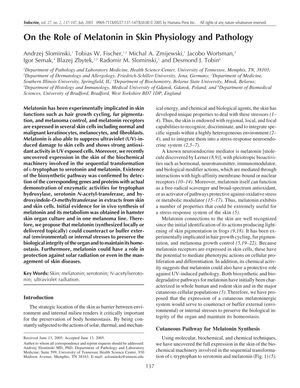TLDR Melatonin is important for skin health and protection, and can be made by the skin or applied to it.
In the 2005 study "On the Role of Melatonin in Skin Physiology and Pathology," melatonin was found to play a significant role in various skin functions, including hair growth cycling, fur pigmentation, and melanoma control. The study confirmed the presence of melatonin receptors in skin cells such as keratinocytes, melanocytes, and fibroblasts. Melatonin demonstrated the ability to reduce ultraviolet-induced damage and exhibited strong antioxidant properties in UV-exposed cells. The research also revealed the skin's capacity to synthesize melatonin through the detection of genes and proteins responsible for converting l-tryptophan to serotonin and melatonin, with enzymatic activities confirmed in skin extracts. Evidence of in vivo melatonin synthesis and metabolism was observed in hamster skin organ culture and a melanoma cell line. The study suggests that melatonin, whether synthesized in the skin or applied topically, could help protect the skin from environmental and internal stress, maintain homeostasis, and potentially aid in managing skin diseases and protecting against solar radiation.
 52 citations
,
January 2005 in “International journal of experimental pathology”
52 citations
,
January 2005 in “International journal of experimental pathology” Melatonin may reduce skin damage caused by X-rays in rats.
 349 citations
,
January 2005 in “The FASEB journal”
349 citations
,
January 2005 in “The FASEB journal” Human skin can make serotonin and melatonin, which help protect and maintain it.
450 citations
,
January 2005 in “The journal of investigative dermatology/Journal of investigative dermatology” Hair color is determined by melanin produced and transferred in hair follicles.
 78 citations
,
February 2004 in “British Journal of Dermatology”
78 citations
,
February 2004 in “British Journal of Dermatology” Melatonin helps hair growth in women with hair loss.
 84 citations
,
July 2003 in “European journal of biochemistry”
84 citations
,
July 2003 in “European journal of biochemistry” Mouse skin can produce and process serotonin, with variations depending on hair cycle, body location, and mouse strain.
 249 citations
,
April 2002 in “The FASEB journal”
249 citations
,
April 2002 in “The FASEB journal” Human skin can make serotonin and melatonin.
56 citations
,
August 1994 in “PubMed” Prolactin and melatonin can stimulate hair growth in Cashmere goat hair follicles, but melatonin may reduce follicle viability over time.
 57 citations
,
February 1994 in “Experimental dermatology”
57 citations
,
February 1994 in “Experimental dermatology” Melatonin affects mouse skin and may regulate skin functions.
48 citations
,
September 1993 in “The journal of experimental zoology/Journal of experimental zoology” Melatonin treatment started hair growth in goats and affected their hormone levels.
 122 citations
,
July 2005 in “The FASEB journal”
122 citations
,
July 2005 in “The FASEB journal” Hair follicles produce and respond to melatonin, affecting hair growth and sensitivity to estrogen.
 109 citations
,
October 2007 in “Journal of pineal research”
109 citations
,
October 2007 in “Journal of pineal research” Melatonin helps regulate hair growth and protects the hair follicle from stress.
 66 citations
,
July 2015 in “Journal of Molecular Biology”
66 citations
,
July 2015 in “Journal of Molecular Biology” The document concludes that for hair and feather growth, it's better to target the environment around stem cells than the cells themselves.
 349 citations
,
January 2005 in “The FASEB journal”
349 citations
,
January 2005 in “The FASEB journal” Human skin can make serotonin and melatonin, which help protect and maintain it.
 15 citations
,
June 2020 in “Experimental Dermatology”
15 citations
,
June 2020 in “Experimental Dermatology” Hormones and genes affect hair growth and male baldness.










